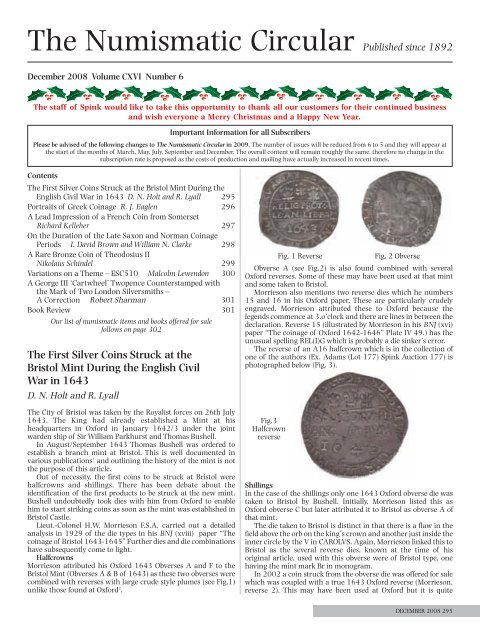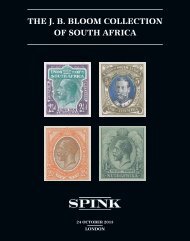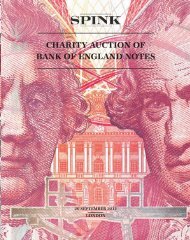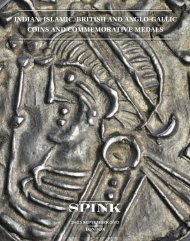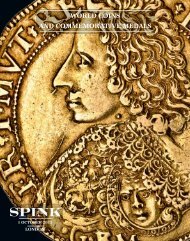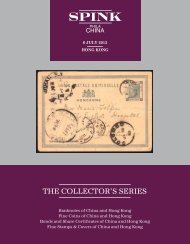SPINK & SON LTD69 Southampton RowBloomsbury London WC1B 4ETTelephone: +44 (0)20 7563 4000Fax: +44 (0)20 7563 4066e-mail: info@spink.comweb site: www.spink.comHours of Business: Mon–Fri 9.30–5.30ISSN 0263-7677Banking InformationThe Royal Bank of Scotland plcLondon Holborn Branch127-129 High HolbornLondon WC1V 6PQSort Code: 16-00-53Account No: 10100317Account Name: <strong>Spink</strong> & Son LtdVAT No GB 791 6271 08We accept payments by Visa,Mastercard, Solo and Maestro.Please see order formfor details.COIN DEPARTMENTAncient CoinsJohn PettBritish Hammered, Milled, Medals and TokensPaul Dawson David GuestMegan Gooch May Sinclair (Consultant)NUMISMATIC AUCTIONSRichard Bishop William MackayBarbara Mears (Consultant)BANKNOTESBarnaby FaullMEDALS, ORDERS AND DECORATONSMark Quayle Henry MeadowsOliver Pepys John Hayward (Consultant)BULLIONBen McLoughlinNUMISMATIC PUBLICATIONSPhilip SkingleyCatherine GathercoleSPINK (ASIA) PTE LTD.Gary TanTelephone: 00 65 6339 8801e-mail: gtan@spink.com.sgDIGITAL IMAGING ADMINISTRATORAndrew WilliamsCONDITIONS OF BUSINESS1 GENERAL These conditions relate to the sale of oneor more items identified in this invoice sold to you‘the Buyer’ by <strong>Spink</strong> & Son Limited ‘the Seller’. Theitem(s) concerned are referred to below as ‘theProperty’. These conditions set out all the terms ofthe agreement between the Buyer and the Seller forthe sale of the Property, other than the purchaseprice. A variation of these Conditions shall only bebinding on the Seller if it is made in writing andsigned by a duly authorised representative of theSeller.2 PAYMENT TERMS AND METHOD Unless otherterms or method of payment are agreed in advance,the purchase price shall be paid in full immediatelyon receiving this invoice. If the Buyer resides in theUnited Kingdom, payment should be made by cash orcheque, made payable to ‘<strong>Spink</strong> & Son Ltd’. If theBuyer resides outside the United Kingdom, paymentshould be by banker’s draft payable to ‘<strong>Spink</strong> & SonLtd’ or direct to: our Sterling Bank Account (detailsabove), quoting invoice number and client number.Payment may also be made by Debit or Credit cardbut please be aware that payment made by VISA,MASTERCARD or AMEX now carries an additionalcharge of 2%, no surcharge is applied on Debit Cardspayments. Payment should be in sterling unlessanother currency is shown on the invoice.3 DELIVERY AND PASSING OF RISK Unless otherwiseagreed the Buyer will collect the Property fromthe Seller not later than 30 days from the date of thisinvoice. As soon as the Seller has delivered theProperty by this or another agreed method the risk ofloss or damage to the Property will pass to the Buyerand the Buyer will become responsible for insuringthe Property. The Buyer shall examine the Propertyupon receipt and notify the Seller promptly of anydamage to or loss of the Property.4 PASSING OF OWNERSHIP Title in the Propertywill not pass to the Buyer until the Seller has receivedcleared funds representing the full purchase price. Ifthe Buyer has possession of the Property before fullpayment has been made the Buyer will, unless theSeller agrees otherwise in advance: keep possession ofthe Property and not sell or dispose of any interest in,or otherwise part with possession of, the Property;preserve the Property in the same state as it was ondelivery; allow the Seller or the Seller’s authorisedagents access to the Property in order to inspect it. Ifthe Buyer does resell the Property any proceedsreceived by the Buyer shall be held in trust for theSeller. If the purchase price is not paid in full 14 daysafter the agreed date the Seller will be entitled torepossess the Property from the Buyer.5 REMEDIES FOR NON-PAYMENT OR FAILURE TOCOLLECT If the Buyer fails to make payment or collectthe Property within the agreed period, the Sellershall be entitled to exercise one or more of the followingrights or remedies: to charge interest on theunpaid amount of the purchase price at a rate of 4%per annum above Royal Bank of Scotland plc baserate; to set off against the unpaid amount of the purchaseprice any amounts which the Seller, or anyassociated company of the Seller, may owe to theBuyer for any other transaction; to exercise a lien onany of the Buyer’s property which may be in theSeller‘s possession, or that of any associated companyof the Seller, for any purpose and,following 14 days notice to the Buyer, arrange thesale of such property and apply the proceeds in dischargeof the amount outstanding; to cancel the sale;to resell the Property and, if this results in a lowerprice being obtained, claim the balance from theBuyer.6 WARRANTY Any description of the Property orstatement by the Seller, whether oral or in writing, isa statement of opinion only and is not to be relied onas a statement of fact. Any statement about damageand/or restoration is for guidance only and theabsence of such a reference does not imply that anitem is free from defects or restoration, nor does a referenceto particular defects imply the absence of anyothers. Although the Seller takes no responsibility forthe correctness of any statement of the kind referredto above, the Seller will refund the Buyer the purchaseprice in full if, within 5 years after the date ofcompletion of the sale, the Buyer notifies the Sellerin writing that the Property is a forgery; the Buyerthen returns the Property to the Seller within 14days and as soon as possible afterwards, the Buyerproduces evidence satisfactory to the Seller that theProperty is a forgery. For the purposes of the thisagreement, the Property is a forgery if it constitutesan imitation originally conceived and executed as awhole with a fraudulent intention to deceive as to theauthorship, origin, age, period, culture or sourcewhere the correct description was not reflected by thedescription applied to the Property at the date of thepurchase by the Buyer and which at that date had avalue materially less than it would have had if it hadbeen in accordance with the description applied to it.Accordingly, no Property is capable of being a forgeryby reason of any damage and/or restoration work ofany kind including repainting/re-enamelling.7 COPYRIGHT The copyright in all images, illustrationsand written material relating to the Property isand shall remain at all times the property of theSeller and shall not be used by the Buyer nor anyoneelse without the Seller’s prior written consent.8 LAW AND JURISDICTION This agreement shall begoverned by and construed in accordance withEnglish law and the Buyer agrees to submit to theexclusive jurisdiction of the English Courts.ANNUAL SUBSCRIPTIONfor 6 issues (February, April, June,August/September, October, December)U.K. £20 Europe £25;rest of world, by air only, £40;US $60 or equivalent.We cannot guarantee to supply back numbers.© <strong>Spink</strong> & Son Ltd, 2008. All rights reserved. No partof this publication may be reproduced, stored in aretrieval system, or transmitted, in any form or byany means, electronic, mechanical, photocopying,recording or otherwise, without the prior permissionof <strong>Spink</strong> & Son Limited.STANDARD WORKS OF REFERENCE USEDB/BABELON: Traité des Monnaies Grecques etRomainesBCV/SEAR: Byzantine Coins and Their ValuesBELL/BELL: Tradesmen’s Tickets and Tokens1785–1819BHM/BROWN: British HistoricalMedals,1760–1960BMC/British Museum CatalogueBN/MORRISON: Catalogue des Monnaies ByzantinesBR/BROOKE: English CoinsBW/WILLIAMSON’S edition of Boyne: Trade Tokensof the Seventeenth CenturyC/COHEN: Monnaies Imperiales, 2e editionCNI/Corpus Nummorum ItalicorumCr/CRAWFORD: Roman Republican CoinageDICKINSON, Michael. 17th Century Tokens of theBritish Isles and Their ValuesD.F./<strong>Spink</strong>’s Catalogue of British CommemorativeMedals 1558 to the present day by D. FearonD&F/DOWLE and FINN: The Guide Book to theCoinage of Ireland, A.D. 995 to presentDH/DALTON and HAMER: Provincial Token Coinageof the 18th CenturyDO/Dumbarton Oaks CatalogueDV/DAVIS: The Nineteenth Century Token CoinageELIAS: The Anglo-Gallic CoinsEMC/COPE and RAYNER: Standard Catalogue ofEnglish Milled Coinage 1662–1972ESC/English Silver Coinage from 1649Fr/The Bronze Coinage of Great BritainGobl/R. GOBL: Sasanian NumismaticsH/HEAD: Historia NumorumHeiss/HEISS: Monnaies Antiques de l’EspagneL&S/LINECAR and STONE: English Proof and PatternCrown Size Pieces 1658–1960LRBC/CARSON, HILL and KENT: Late Roman BronzeCoinageMack/MACK: The Coinage of Ancient BritainM./MARSH: The Gold SovereignMCE/Milled Coinage of EnglandMesh/Y. MESHORER: Jewish CoinsMI/HAWKINS, FRANK and GRUEBER: MedallicIllustrations of British HistoryMilne/MILNE: Catalogue of Alexandrian CoinsMitch/MITCHINER: Indo-Greek and Indo-ScythianCoinage (9 volumes)N/NORTH: English Hammered Coinage (2 volumes)P/PECK: English Copper, Tin and Bronze Coins in theBritish Museum, 1558–1958Parsons/PARSONS: The Coinage of British AfricaPr/PRIDMORE: The Coinage of the BritishCommonwealth of Nations (4 parts)Ratto/Ratto Catalogue, Monnaies ByzantinesRCV/SEAR: Roman Coins and Their ValuesRIC/Ed. SUTHERLAND and CARSON: The RomanImperial CoinageS/SYDENHAM: Coinage of the Roman RepublicS/(English Coins) <strong>Spink</strong> Standard CatalogueSCBI: Sylloge of Coins of the British IslesSellwood/SELLWOOD: An Introduction to theCoinage of ParthiaSNG ANS/Syllogue Nummorum Graecorum:American Numismatic SocietySNG Cop/Sylloge Nummorum Graecorum:Danish National Museum, CopenhagenSNG/Sylloge Numorum GraecorumSNG v. Aul/Syllogue Nummorum Graecorum:Sammlung Hans von AulockSt/STEWART: The Scottish CoinageVA/VAN ARSDELL: Celtic Coinage of BritainW/WITHERS: British Copper Tokens 1811-1820WR/WILSON and RASMUSSEN: English Pattern, Trialand Proof Coins in Gold 1547-1968ABBREVIATIONSGeneral¡ = Gold ¿ = Silver Æ = BronzeWM = White Metal Mm = Mint or initial markObv = Obverse W = ReverseMM = millimetre g = grammemgm = monogramRarityR = Rare RR = Very rare RRR = Extremely rareRRRR = Highest rarityR 1 –R 7 7 also used for 19th and 20th CenturyEnglish Copper Coins and modern pieces from1662ConditionFDC = Fleur de coin, mint stateEF = Extremely FineVF = Very Fine F = Fine f = fairM = Moderate P = PoorUNC = Uncirculated (Modern Coins)VG = Very Good: F+ (Banknote lists)Any two of the above may be used in conjunctionas followsF/VF = Obverse Fine, Reverse Very FineVF-EF = General condition between VF and EFINSURANCEA charge will be made for insurance of coins &medals, details on Order Form.POSTAGE AND INSURANCEInsurance (including p+p) will be charged on thefollowing scale:UK including Northern Ireland:Coins = £5.00;Books up to1kg = £5.00Books up to2kg = £6.50International Registered:EU:Coins = £6.00;Books up to1kg = £8.00Books up to2kg = £14.00Rest of the World:Coins = £10.00;Books up to1kg = £12.00Books up to2kg = £20.00Books sent by this method are not covered byinsurance. Please note that shipping may takearound 10 working days<strong>Spink</strong> cannot be responsible for supplying informationabout local taxes where they may apply.The buyer is solely responsible for paying anysuch taxes as charged.294 NUMISMATIC CIRCULARPrinted in England by Pardy & Son (Printers) Ltd Parkside, Ringwood, Hampshire BH24 3SF
The Numismatic Circular Published since 1892December 2008 Volume CXVI Number 6The staff of <strong>Spink</strong> would like to take this opportunity to thank all our customers for their continued businessand wish everyone a Merry Christmas and a Happy New Year.Important Information for all SubscribersPlease be advised of the following changes to The Numismatic Circular in 2009. The number of issues will be reduced from 6 to 5 and they will appear atthe start of the months of March, May, July, September and December. The overall content will remain roughly the same, therefore no change in thesubscription rate is proposed as the costs of production and mailing have actually increased in recent times.ContentsThe First Silver Coins Struck at the Bristol Mint During theEnglish Civil War in 1643 D. N. Holt and R. Lyall 295Portraits of Greek Coinage R. J. Eaglen 296A Lead Impression of a French Coin from SomersetRichard Kelleher 297On the Duration of the Late Saxon and Norman CoinagePeriods I. David Brown and William N. Clarke 298A Rare Bronze Coin of Theodosius IINikolaus Schindel 299Variations on a Theme – ESC510 Malcolm Lewendon 300A George III ‘Cartwheel’ Twopence Counterstamped withthe Mark of Two London Silversmiths –A Correction Robert Sharman 301Book Review 301Our list of numismatic items and books offered for salefollows on page 302The First Silver Coins Struck at theBristol Mint During the English CivilWar in 1643D. N. Holt and R. LyallThe City of Bristol was taken by the Royalist forces on 26th July1643. The King had already established a Mint at hisheadquarters in Oxford in January 1642/3 under the jointwarden ship of Sir William Parkhurst and Thomas Bushell.In August/September 1643 Thomas Bushell was ordered toestablish a branch mint at Bristol. This is well documented invarious publications 1 and outlining the history of the mint is notthe purpose of this article.Out of necessity, the first coins to be struck at Bristol werehalfcrowns and shillings. There has been debate about theidentification of the first products to be struck at the new mint.Bushell undoubtedly took dies with him from Oxford to enablehim to start striking coins as soon as the mint was established inBristol Castle.Lieut.-Colonel H.W. Morrieson F.S.A. carried out a detailedanalysis in 1929 of the die types in his BNJ (xviii) paper “Thecoinage of Bristol 1643-1645” Further dies and die combinationshave subsequently come to light.HalfcrownsMorrieson attributed his Oxford 1643 Obverses A and F to theBristol Mint (Obverses A & B of 1643) as these two obverses werecombined with reverses with large crude style plumes (see Fig.1)unlike those found at Oxford 2 .Fig. 1 ReverseFig. 2 ObverseObverse A (see Fig.2) is also found combined with severalOxford reverses. Some of these may have been used at that mintand some taken to Bristol.Morrieson also mentions two reverse dies which he numbers15 and 16 in his Oxford paper. These are particularly crudelyengraved. Morrieson attributed these to Oxford because thelegends commence at 3.o’clock and there are lines in between thedeclaration. Reverse 15 (illustrated by Morrieson in his BNJ (xvi)paper “The coinage of Oxford 1642-1646” Plate IV 49.) has theunusual spelling REL(I)G which is probably a die sinker’s error.The reverse of an A16 halfcrown which is in the collection ofone of the authors (Ex. Adams (Lot 177) <strong>Spink</strong> Auction 177) isphotographed below (Fig. 3).Fig.3HalfcrownreverseShillingsIn the case of the shillings only one 1643 Oxford obverse die wastaken to Bristol by Bushell. Initially, Morrieson listed this asOxford obverse C but later attributed it to Bristol as obverse A ofthat mint.The die taken to Bristol is distinct in that there is a flaw in thefield above the orb on the king’s crown and another just inside theinner circle by the V in CAROLVS. Again, Morrieson linked this toBristol as the several reverse dies, known at the time of hisoriginal article, used with this obverse were of Bristol type, onehaving the mint mark Br in monogram.In 2002 a coin struck from the obverse die was offered for salewhich was coupled with a true 1643 Oxford reverse (Morrieson,reverse 2). This may have been used at Oxford but it is quiteDECEMBER 2008 295
- Page 1: NumismaticCircularDECEMBER2008Volum
- Page 6 and 7: feasible that both these dies were
- Page 9 and 10: into the first twenty four years of
- Page 11 and 12: A George III ‘Cartwheel’ Twopen
- Page 13 and 14: GK2607 Kingdom of Macedon, Demetrio
- Page 15 and 16: RomanAll minted at Rome unless othe
- Page 17 and 18: RM3934 Commodus (AD 177-192), Æ Du
- Page 19 and 20: HS3614 Early Uninscribed, ¡ Quarte
- Page 21 and 22: HS3643 William I, Penny, 1.44g, PAX
- Page 23 and 24: HS3664 Henry VIII, posthumous coina
- Page 25 and 26: HS3685 Charles I, Oxford, Shilling,
- Page 27 and 28: S09 Elizabeth I, Shilling, 5.87g, s
- Page 29 and 30: S33 Victoria, Shilling, 1880, type
- Page 31 and 32: Milled SilverCROWNSMS8695 William I
- Page 33 and 34: MS8707 Victoria, Crown, 1888, Jubil
- Page 35 and 36: MS8732 James II (1685-88), Sixpence
- Page 37 and 38: IO724 Iran, Qajar Dynasty, Fath ‘
- Page 39 and 40: 37 LE RIDER, G. Le Monnayage d’Ar
- Page 41 and 42: 133 JUDD, J.H. United States Patter


